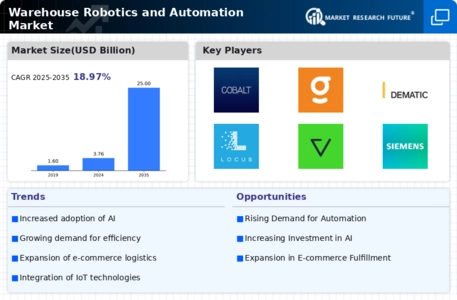The Warehouse Robotics Automation Market is currently characterized by a dynamic competitive landscape, driven by technological advancements and increasing demand for efficiency in logistics and supply chain operations. Key players such as Amazon Robotics (US), GreyOrange (IN), and Boston Dynamics (US) are at the forefront, each adopting distinct strategies to enhance their market positioning. Amazon Robotics (US) continues to innovate with its autonomous mobile robots, focusing on integrating AI and machine learning to optimize warehouse operations. Meanwhile, GreyOrange (IN) emphasizes its software-driven approach, enhancing the adaptability of its robotic systems to meet diverse customer needs. Boston Dynamics (US), known for its advanced robotics, is leveraging partnerships to expand its reach in various sectors, thereby shaping a competitive environment that prioritizes technological prowess and operational efficiency.
In terms of business tactics, companies are increasingly localizing manufacturing and optimizing supply chains to mitigate risks and enhance responsiveness. The market appears moderately fragmented, with several players vying for dominance. However, the collective influence of major companies is significant, as they drive innovation and set benchmarks for operational excellence. This competitive structure fosters an environment where agility and technological advancement are paramount, compelling companies to continuously evolve their strategies.
In November 2025, Amazon Robotics (US) announced the launch of its latest generation of autonomous robots, designed to improve inventory management and reduce operational costs by up to 30%. This strategic move underscores Amazon's commitment to maintaining its leadership position through continuous innovation and efficiency gains. The introduction of these robots is likely to enhance the overall productivity of warehouses, further solidifying Amazon's competitive edge in the market.
In October 2025, GreyOrange (IN) secured a strategic partnership with a leading logistics provider to implement its AI-driven robotics solutions across multiple distribution centers. This collaboration is expected to enhance operational efficiency and scalability, allowing GreyOrange to penetrate new markets more effectively. The partnership reflects a growing trend of companies leveraging alliances to expand their technological capabilities and market reach.
In September 2025, Boston Dynamics (US) unveiled a new robotic system capable of performing complex tasks in dynamic environments, aimed at sectors beyond traditional warehousing. This development indicates a strategic pivot towards versatility and adaptability, positioning Boston Dynamics to capture emerging opportunities in various industries. The ability to operate in diverse settings may provide a competitive advantage as demand for multifunctional robotics increases.
As of December 2025, the Warehouse Robotics Automation Market is witnessing trends such as digitalization, sustainability, and AI integration, which are reshaping competitive dynamics. Strategic alliances are becoming increasingly vital, as companies seek to enhance their technological capabilities and market presence. The competitive differentiation is likely to evolve from price-based competition to a focus on innovation, technology, and supply chain reliability, suggesting a future where agility and advanced capabilities are the key determinants of success.
















Leave a Comment